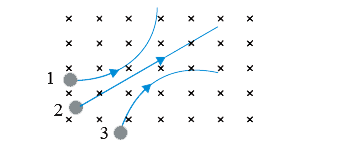Orbits of a particle moving in a circle are such that the perimeter of the orbit equals an integer number of de-Broglie wavelengths of the particle. For a charged particle moving in a plane perpendicular to a magnetic field, the radius of the nth orbital will therefore be proportional to:
n2
n
n1/2
n1/4
The correct Answer is:C
To solve the problem, we need to analyze the motion of a charged particle in a magnetic field and relate it to the de Broglie wavelength condition.
1. Understanding the de Broglie Wavelength Condition:
The condition states that the perimeter of the orbit (circumference) is an integer multiple of the de Broglie wavelength. Mathematically, this can be expressed as:
2πr=nλ
where r is the radius of the orbit, n is an integer, and λ is the de Broglie wavelength given by:
λ=hp
where p is the momentum of the particle and h is Planck's constant.
2. Relating Momentum to Velocity:
For a charged particle moving in a magnetic field, the momentum p can be expressed as:
p=mv
where m is the mass of the particle and v is its velocity.
3. Setting Up the Forces:
The magnetic force acting on the particle is given by:
Fmagnetic=qvB
where q is the charge of the particle and B is the magnetic field strength. This magnetic force provides the necessary centripetal force to keep the particle in circular motion:
Fcentripetal=mv2r
4. Equating Forces:
Setting the magnetic force equal to the centripetal force gives:
qvB=mv2r
5. Rearranging the Equation:
Rearranging the above equation to solve for r:
r=mvqB
6. Substituting Momentum:
Now substitute p=mv into the equation for r:
r=pqB
7. Using the de Broglie Wavelength:
From the de Broglie wavelength condition, we have:
p=nh2πr
Substituting this expression for p into the equation for r:
r=nh2πqBr
8. Solving for r:
Rearranging gives:
r2=nh2πqB
Therefore, we find that:
r∝√n
Conclusion:
Thus, the radius of the nth orbital is proportional to √n:
r∝√n
The condition states that the perimeter of the orbit (circumference) is an integer multiple of the de Broglie wavelength. Mathematically, this can be expressed as:
2πr=nλ
where r is the radius of the orbit, n is an integer, and λ is the de Broglie wavelength given by:
λ=hp
where p is the momentum of the particle and h is Planck's constant.
For a charged particle moving in a magnetic field, the momentum p can be expressed as:
p=mv
where m is the mass of the particle and v is its velocity.
The magnetic force acting on the particle is given by:
Fmagnetic=qvB
where q is the charge of the particle and B is the magnetic field strength. This magnetic force provides the necessary centripetal force to keep the particle in circular motion:
Fcentripetal=mv2r
Setting the magnetic force equal to the centripetal force gives:
qvB=mv2r
Rearranging the above equation to solve for r:
r=mvqB
Now substitute p=mv into the equation for r:
r=pqB
From the de Broglie wavelength condition, we have:
p=nh2πr
Substituting this expression for p into the equation for r:
r=nh2πqBr
Rearranging gives:
r2=nh2πqB
Therefore, we find that:
r∝√n
Thus, the radius of the nth orbital is proportional to √n:
r∝√n
Topper's Solved these Questions
- ATOMSBOOK - DISHA PUBLICATIONCHAPTER - ATOMSEXERCISE - EXERCISE-1: CONCEPT BUILDER (TOPICWISE)
60 Videos
- ALTERNATING CURRENT BOOK - DISHA PUBLICATIONCHAPTER - ALTERNATING CURRENT EXERCISE - Exercise -2 : Concept Applicator
30 Videos
- CHAPTERWISE NUMERIC /INTEGER ANSWER QUESTIONSBOOK - DISHA PUBLICATIONCHAPTER - CHAPTERWISE NUMERIC /INTEGER ANSWER QUESTIONSEXERCISE - CHAPTER 29 : (COMMUNICATION SYSTEMS)
15 Videos
Similar Questions
Knowledge Check
A charge particle is moving in a plane perpendicular to uniform magnetic field, then
AIts momentum changes but kinetic energy remains the sameBBoth momentum and kinetic energy remain the sameCBoth will changeDKinetic energy change but momentum remains the sameWhen a charged particle moves perpendicular to a magnetic field, then:
Aspeed of the particle is changedBspeed of the particle remains unchangedCdirection of the particle remains unchangedDacceleration of the particle remains unchangedWhen a charged particle moves perpendicular to a magnetic field, then:
Aspeed of the particles is changedBspeed of the particle remains unchangedCdirection of motion of the particle remains unchangedDacceleration of the particle remains unchanged
The radius of curvature of the path of a charged particle moving in a static uniform magnetic field is
View SolutionThe radius of curvature of the path of a charged particle moving in a static uniform magnetic field is
View SolutionIf the direction of the initial velocity of a charged particle is neither along nor perpendicular to that of the magnetic field, then the orbit will be
View SolutionThe ratio of de broglie wavelength of a proton and an alpha particle moving with the same velocity is
View SolutionA particle moving in a magnetic field increases its velocity, then its radius of the circle
View Solution

